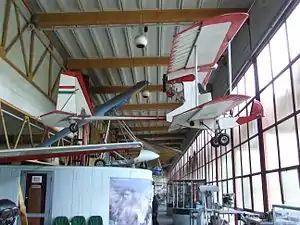Hovey Whing Ding
The Hovey Whing Ding is an extremely minimalist American ultralight aircraft that was designed by Bob Hovey of Saugus, California, first flying in 1971. The aircraft is supplied in the form of plans for amateur construction by the Vintage Ultralight and Lightplane Association of Marietta, Georgia.[1][2][3]
| Whing Ding II | |
|---|---|
 | |
| Role | Ultralight aircraft |
| National origin | United States |
| Manufacturer | Vintage Ultralight and Lightplane Association |
| Designer | Bob Hovey |
| First flight | February 1971 |
| Status | Plans available (2014) |
| Variants | Hovey Delta Bird |
Design and development
Hovey set out to create the lightest aircraft to carry a person ever to fly, with the resulting design being a biplane, with a plywood box filled with Polyurethane foam serving as the fuselage, supporting the pilot's seat. The aircraft features a conventional fabric-covered empennage carried at the end of a short tailboom made of aluminum tube. The horizontal stabilizer is made from reinforced cardboard. Early versions used wing warping for roll control, while later models used full-span ailerons. The specified pusher configuration powerplant is a McCulloch chainsaw engine turning a hand-carved wooden propeller via a chain drive. The first prototype had a monowheel undercarriage, with skids under the wingtips, but this was soon changed to twin mainwheels carried on a spring-type strut. With no brakes to stop the aircraft after landing, pilots were supposed to press their heels against the mainwheels.[1][4]
The Whing Ding was designed long before the US FAR 103 Ultralight Vehicles regulations were introduced, but it fully conforms to the rules. The Whing Ding helped generate interest in ultralight aircraft and lead to the ultralight boom of the late 1970s and 1980s.[1]
Hovey conceived of the aircraft as an experimental project and not as a form of transportation. Due to its unreliable powerplant he intended it to only be flown over open areas where a safe landing could be carried out at any time. The plans were complex to follow and were not intended to make construction easy. Construction time typically is about 400 hours.[2][4]
The Whing Ding was marketed as plans, and sold extremely well - by 1979, over 6,000 sets had been purchased. In 2011 the plans were still available, and at no cost.[2]
Operational history
Depending on the density altitude and the weight of the pilot, some builders discovered that the aircraft was under powered and suffered from too small a wing area to climb out of ground effect.[1]
Variants
Specifications (typical)
Data from Cliche and the Virtual Ultralight Museum[1][2]
General characteristics
- Crew: one
- Length: 14 ft (4.3 m)
- Wingspan: 17 ft (5.2 m)
- Height: 5 ft 6 in (1.68 m)
- Wing area: 98 sq ft (9.1 m2)
- Empty weight: 122 lb (55 kg)
- Gross weight: 300 lb (136 kg)
- Fuel capacity: 0.5 U.S. gallons (1.9 L; 0.42 imp gal)
- Powerplant: 1 × McCulloch MAC-101 chain saw engine, 12.5 hp (9.3 kW)
- Propellers: 2-bladed hand carved wooden propeller
Performance
- Maximum speed: 50 mph (80 km/h, 43 kn)
- Cruise speed: 40 mph (64 km/h, 35 kn)
- Stall speed: 26 mph (42 km/h, 23 kn)
- Range: 20 mi (32 km, 17 nmi)
- Service ceiling: 4,000 ft (1,200 m)
- g limits: +3/-3
- Rate of climb: 100 ft/min (0.51 m/s)
Avionics
- none
References
- Cliche, Andre: Ultralight Aircraft Shopper's Guide 8th Edition, page E-43. Cybair Limited Publishing, 2001. ISBN 0-9680628-1-4
- Virtual Ultralight Museum (n.d.). "Whing Ding II". Retrieved 4 January 2012.
- Perkins, Scott, V.U.L.A. Vintage Ultralight and Lightplane Assoc. (2004). "Blueprints Price List". Archived from the original on 20 August 2014. Retrieved 23 April 2014.
- AirVenture Museum (2012). "Hovey/Estupinan WD-11 "Whing Ding" – N6272". Retrieved 4 January 2012.
- Taylor, Michael J. H. (1989). Jane's Encyclopedia of Aviation. London: Studio Editions. p. 511.
- Jane's All the World's Aircraft 1976-77. London: Jane's Yearbooks. pp. 543–44.
External links
- Photo of a Whing Ding
- World’s lightest aircraft? Popular Mechanics, September 1973, p. 112 (brief news note on Whing Ding II).